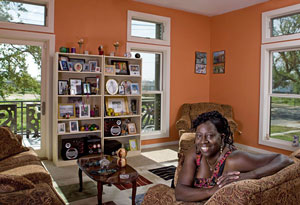Rebuilding New Orleans—The Green Way

Photo: Alexei Lebedev/Momenta
Five years ago, Hurricane Katrina wiped out the life she knew. Now Melba Leggett-Barnes has a place to call her own again—a home that's good for her and the planet.
Melba Leggett-Barnes stands in slippers on the roof of her house in the Lower Ninth Ward of New Orleans. It's a blazing August afternoon, yet this mother of five and grandmother of six is gripping an orange mop and wiping down 15 metallic solar panels, each about the size of a picnic table. "I like to make sure all the sun gets through," she says over the clamor of nearby construction work. "Every last drop is money in my pocket." From her roof, Leggett-Barnes can see dozens of other new homes like hers. With their sharp angles and tropical-fruit hues (mango orange, papaya pink, banana yellow), these houses suggest giant origami sculptures more than traditional New Orleans architecture, known for its deep front porches and curvaceous woodwork. In the blighted Lower Ninth, this vibrant micro-neighborhood seems surreal—an architectural mirage.
On the western border of the two-square-mile area, the levees broke on August 29, 2005, in the wake of Hurricane Katrina. The floodwaters left some 14,000 residents homeless, including Leggett-Barnes and her husband, Baxter. Yielding to the evacuation order, they had packed a few clothes and documents in their car and inched through traffic to her cousin's house in Baker, Louisiana, 100 miles north. They came home to an empty lot. "Scraps were the only thing left," she recalls. "Pieces of the fence, the porch my daddy built, the wheel of my granddaughter's bike."
Today whole city blocks of the Lower Ninth still stand vacant. The hurricane destroyed more than 4,000 homes in the area; fewer than 200 have been rebuilt. Roughly 75 percent of local families are still displaced, staying in FEMA trailers or with relatives across the southeast and beyond.
But Melba Leggett-Barnes is back. The 53-year-old school cafeteria worker, born and bred in New Orleans, is living on the same plot of land her family has owned for generations: one-tenth of an acre just two blocks east of the collapsed floodwall. And in returning to her neighborhood, Leggett-Barnes has also become part of a radical experiment to prove that a 21st-century house can be at once affordable and sustainable.
Leggett-Barnes and her family are some of the first homeowners in what will become a 150-house community constructed by the nonprofit Make It Right foundation, established by Brad Pitt in 2007 to build environmentally sound residences for low- and middle-income families. "We're cracking the code on affordable green homes," says Pitt, who envisions the Lower Ninth neighborhood as "a 'proof-of-concept' for low-income green building nationally, maybe even worldwide."
A Make It Right house is eco-friendly from top to bottom, using at least 70 percent less energy than a conventional house of the same size. "We don't just want to make homes 'less bad' for the environment," Pitt says. "We want them instead to have an environmental benefit." Thanks to their ventilation systems and solar technology, Make It Right houses emulate trees, purifying the air rather than polluting it and harnessing the sun's rays to produce more energy than they consume. The homes are available exclusively to people who lived in the Lower Ninth before Katrina, and Make It Right guides families through the financing process.
"People assume green is only for rich folks, and we're showing that's not true," says green architect William McDonough, a founding partner in Make It Right. Yet costs do remain a challenge. The average Make It Right house currently takes more than $200,000 to build, well over their goal of $150,000. The foundation, not the homebuyers, covers the difference.
"With every house we build," McDonough adds, "we're finding ways to make them more affordable." Make It Right has offered contractors incentives to find cost-saving construction methods and supplies, allowing them to keep half of every dollar saved. (Thrifty innovations so far have included streamlined rigging for solar panels and modular walls that snap into place without expensive joists.) In constructing its first 50 homes, Make It Right has whittled costs from $200 per square foot to roughly $150 (compared with $135 for conventional building in the Lower Ninth).
"When we put the lid on the last house, it will be dollar-for-dollar the same price as a conventional home," Pitt says. "There will be no excuse to build any other way."



